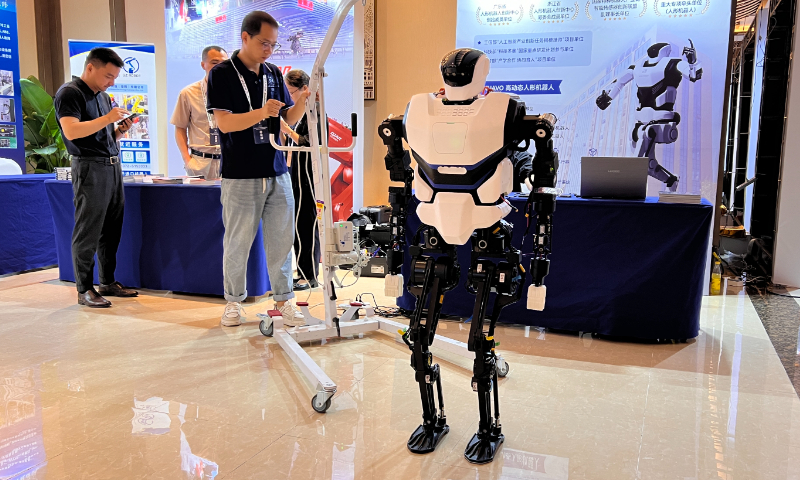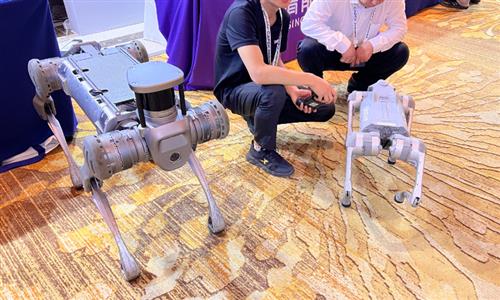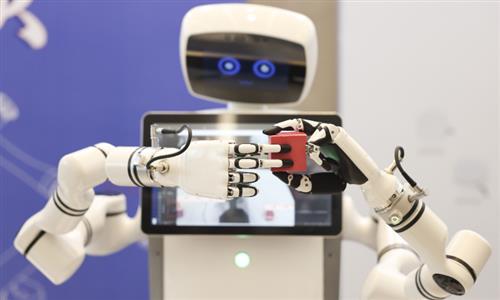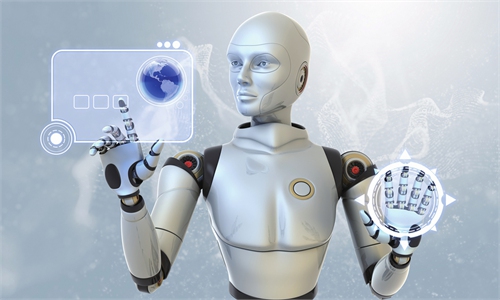Big challenges remain despite rapid progress in humanoid robot development: experts

Kuavo (Kuafu in Chinese) from Shenzhen-based Leju Robotics Photo: Leng Shumei/GT
Practicing Tai Chi like a playful puppy, smoothly hitting ping pong balls, and drawing with precision... a variety of robots showcased their skills and attracted the attention of visitors during the 14th China International Robot Summit Forum and the 10th Capek Award Ceremony in Wuhu, East China's Anhui Province, which ran from Wednesday to Friday.
Among the robot products displayed at the forum, the most eye-catching were two humanoid robots, H1 from Hangzhou-based Unitree Robotics and Kuavo from Shenzhen-based Leju Robotics.
Kuavo is a typical black and white robot. On the opening day of the forum, reporters from the Global Times watched Kuavo practicing Tai Chi. Raising its hands, squatting, and lowering its hands, Kuavo was as steady as a master, leading the reporters and visitors into the realm of Tai Chi.
The all-black H1 was younger and cooler. It ran, jumped, and even performed a dance, which lifted up the atmosphere at the exhibition.
According to Zhao Jie, a professor at Harbin Institute of Technology, humanoid robots are robots that can "perform skillful and dexterous tasks like humans."
Experts at the forum said that humanoid robots are the best example of embodied intelligence. But do robots have to look like humans in the future? Not every expert thought so. The ultimate goal of robot development is to assist humans, and in the future, robots should be more versatile in form and adaptable to different scenarios based on functionality, some of them said.
The development of humanoid robots also faces various technological challenges. Chen Li, co-founder of Unitree Robotics, believes that "tasks like washing, cooking, and making beds are actually not related, and each task has many different steps with a specific sequence. Whether humanoid robots can handle these tasks mainly depends on whether existing foundation models can handle them."
In recent years, the rapid development of foundation models has propelled the rapid advancement of the humanoid robot industry and has become a key factor in the long-term development of humanoid robots. "Considering the current China-US relations, China needs time to catch up in high-performance chip technology. AI computing remains a difficult point," Ji Chao, chief scientist at iFlytek Humanoid Robots, said at the forum.
The chips in domestic humanoid robots still rely to some extent on foreign manufacturers, Zhao noted. "If this continues, the bodies of humanoid robots will be made in China, while their 'brains' are imported. We will be at the low end of the humanoid robot industry chain, while the high end is occupied by others. We need to put more effort into the development of the 'brains' of robots."
Zhao also emphasized that the application of humanoid robots in complex scenarios in the future will create higher demands for the components in the robots, especially their hands. Many humanoid robots' hands are still far from being able to be applied in complex household scenarios.
Sun Lining, a member of the Russian Academy of Engineering, said that in the future, robots should have an operating system similar to smartphones and computers, with human skills implanted into robots so that emotional interaction can be achieved.
Some experts said embodied intelligence will be the trend for humanoid robots in the future. However, Chen said this is still a distant dream. "To achieve embodied intelligence, we first need to make breakthroughs in the understanding and cognition capacity of robots. But what developers in China and abroad, including OpenAI, are doing is still based on data fusion and calculation on the basis of foundation models. The underlying logic is still using some general computational formulas to calculate the model. However, human thinking is not simply a calculation. Humans have emotions, self-awareness, self-cognition, self-worth, self-denial, etc. To truly create robots with perception like humans and even their own thoughts and consciousness, like those in science fiction movies, the difficulty is still very high."
Sun said that the future development potential of the robotics industry lies in interdisciplinarity. "The combination of robots with micro-nano technology has produced the concept of micro-nano robots, and the combination with life sciences has led to developments in medical care. Therefore, the cross-disciplinary development of robots is definitely a key source of vitality," Sun said.



